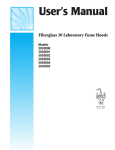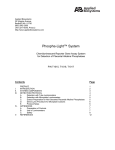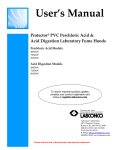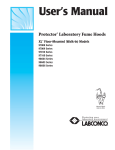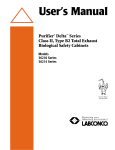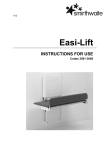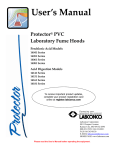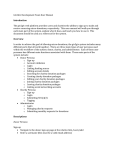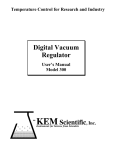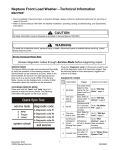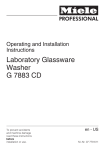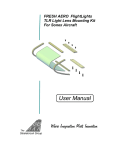Download User`s Manual - CampbellRhea
Transcript
User’s Manual LabShield ® By CampbellRhea ® Laboratory Fume Hoods Air Foil By-Pass Models: 6714, 6716, 6718 ADA Models: 8796, 8798, 8800 Demonstration Hood 6725G CampbellRhea 1865 North Market Street Paris TN 38242 731.642.4251 Fax: 731.642.4262 e-mail: [email protected] website: www.campbellrhea.com Copyright Information All rights reserved. Contacting Contact the following for information concerning; freight damage, warranty and parts, etc. Project Managers Wayne Cathey , Director of Engineering Brian Webb, Engineer Bobby Veazey, Senior Project Manager 731-642-4251 Ext. 323 731-642-4251 Ext. 288 731-642-4251 Ext. 232 Part #9933700, Rev. D, ECO F109 Chapter 1: Introduction 3 TABLE OF CONTENTS CHAPTER 1: INTRODUCTION About This Manual 1 2 CHAPTER 2: PREREQUISITES Location Requirements Support Requirements Exhaust Requirements Electrical Requirements Service Line Requirements 3 3 4 4 4 4 CHAPTER 3: GETTING STARTED Removing the Shipping Skid Sash Weight Release – ByPass & ADA Sash Weight Release – Demonstration Hood Install the LabShield Hood on a Supporting Structure and Work Surface Connecting to the LabShield Hood Exhaust System Connecting the Electrical Supply source to the LabShield Fume Hood Connecting the Service Lines to the LabShield Fume Hood Sealing the LabShield Fume Hood to the Work Surface Certifying the LabShield Fume Hood 5 5 6 6 8 10 10 10 CHAPTER 4: USING YOUR LABSHIELD FUME HOOD Operating the Vertical-Rising Sash Operating the A-Style Combination Sash Operating the Blower Operating the Lights Working in your LabShield Fume Hood 12 12 12 13 13 13 6 8 CHAPTER 5: MAINTAINING YOUR LABSHIELD FUME HOOD 15 Routine Maintenance Schedule 15 Routine Service Operations 16 Chapter 1: Introduction CHAPTER 6: MODIFYING YOUR LABSHIELD FUME HOOD Installing Work Surfaces Installing Ceiling Enclosures above the Fume Hood Installing Rear Panels Behind the Fume Hood Installing Additional Service Fixtures Installing Guardian Digital Airflow Monitor or Guardian Jr. AirflowMonitor Distillation Grids – Field Installation Sash Stop Kit – Field Installation Installing an Electrical Duplex Outlet 17 17 18 18 18 CHAPTER 7: TROUBLESHOOTING 21 APPENDIX A: LABSHIELD FUME HOOD DIMENSIONS 24 APPENDIX B: LABSHIELD FUME HOOD SPECIFICATIONS 27 19 19 20 20 5 CHAPTER 1 INTRODUCTION Congratulations on your purchase of a LabShield Laboratory Fume Hood. Your LabShield Laboratory Fume Hood is designed to protect you. The LabShield Fume Hood has been engineered to provide maximum visibility in a laboratory, and effectively contain toxic, noxious, or other harmful materials when properly installed. The LabShield hoods offer many unique features to enhance safety, performance, and visibility. To take full advantage of them, please acquaint yourself with this manual and keep it handy for future reference. If you are unfamiliar with how fume hoods operate, please review Chapter 4: Using Your LabShield before you begin working in the fume hood. Even if you are an experienced fume hood user, please review Chapter 5: Maintaining Your LabShield, which describes your LabShield Hood’s features so that you can use the hood efficiently. 1 Chapter 1: Introduction About This Manual This manual is designed to help you learn how to install, use, and maintain your laboratory fume hood. Instructions for installing optional equipment on your hood are also included. Chapter 1: Introduction provides a brief overview of the laboratory fume hood, explains the organization of the manual, and defines the typographical conventions used in the manual. Chapter 2: Prerequisites explains what you need to do to prepare your site before you install your laboratory fume hood. Electrical and service requirements are discussed. Chapter 3: Getting Started contains the information you need to properly unpack, inspect, install, and certify your laboratory fume hood. Chapter 4: Using Your LabShield Fume Hood discusses the basic operation of your fume hood. Information on how to prepare, use and shut down your LabShield Hood are included. Chapter 5: Maintaining Your LabShield Fume Hood explains how to perform routine maintenance on your fume hood. Chapter 6: Modifying Your LabShield Fume Hood explains how to modify the fume hood or add accessories. Chapter 7: Troubleshooting contains a table of problems you may encounter while using your laboratory fume hood including the probable causes of the problems and suggested corrective actions. Appendix A: LabShield Fume Hood Dimensions contains comprehensive diagrams showing all of the dimensions for the laboratory fume hoods. Appendix B: LabShield Fume Hood Specifications contains the electrical requirements for laboratory fume hood. Wiring diagrams are also included. 2 CHAPTER 2 PREREQUISITES Before you install your laboratory fume hood, you need to prepare your site for installation. Carefully examine the location where you intend to install your hood. You must be certain that the area is level and of solid construction. In addition, a dedicated source of electrical power must be located near the installation site. Carefully read this chapter to learn the requirements for your installation site: • • • • • • The location requirements. The support requirements. The exhaust requirements. The electrical power requirements. The service line requirements. The space requirements. Refer to Appendix A: LabShield Fume Hood Dimensions for complete fume hood dimensions. Refer to Appendix B: LabShield Fume Hood Specifications for complete laboratory fume hood electrical and environmental conditions, specifications and requirements. Location Requirements The fume hood should be located away from traffic patterns, doors, windows, fans, ventilation registers, and any other air-handling device that could disrupt its airflow patterns. All windows in the room should be closed. Support Requirements DO NOT install the fume hood on a cart, dolly, or mobile bench. ALL LabShield Hood installations must be permanent and stationary. The supporting structure usually consists of a base cabinet or stand and chemically resistant work surface. 3 Chapter 2: Prerequisites Exhaust Requirements The exhaust duct connection on the Bypass and ADA models has been designed for 12" nominal duct (12.09" OD) to allow for minimum static pressure loss while operating at 100 fpm face velocities. The 12" diameter exhaust duct also allows for proper transport velocities away from the hood in the 1000 fpm to 2500 fpm range. The Demonstration Hood has been designed for a 10" nominal duct (10.09").The proper exhaust volume and static pressure loss are listed next for each hood model: Full Open 28" Sash Opening Hood Model Airflow Requirements @100 fpm 6714, 8796 730 cfm @ .16" SP 6716, 8798 960 cfm @ .24" SP 6718, 8800 1180 cfm @ .28" SP 6725G 1100 cfm* @ .40" SP * Sash opening height is only 26" on Pass Thru Hood and only one sash can be open at one time. Electrical Requirements The LabShield Hoods feature internal wiring for the fluorescent light assembly, light switch and blower switch. A qualified electrician can make connections to all internal wiring at the single point wiring junction box on top of the hood. Refer to Chapter 3: Getting Started and Appendix B: LabShield Hood Specifications for the wiring diagram for proper electrical installation. Service Line Requirements All service lines to the laboratory fume hood should be 1/4"outside diameter, copper (brass for natural gas), except for a coldwater gooseneck 3/8" outside diameter and equipped with an easily accessible shut-off valve, should disconnection be required. If the service line pressure exceeds 40 PSI, it must be equipped with a pressure regulator to reduce the line pressure. Please check with local codes for other requirements. 4 CHAPTER 3 GETTING STARTED Now that the site for your laboratory fume hood is properly prepared, you are ready to unpack, inspect, install, and certify your unit. Read this chapter to learn how to: • Unpack and move your LabShield Hood. • Set up the fume hood with the supporting structure and work surface. • Connect to an exhaust system. • Connect the electrical supply source. • Connect the service lines. • Sealing the LabShield Hood to the work surface. • Arrange certification of your LabShield Hood. Depending upon which model you are installing, you may need common plumbing and electrical installation tools in addition to 5/16", 3/8", 7/16", and 1/2" wrenches, ratchets, sockets, a nut driver set, a flat-blade screwdriver, a Phillips screwdriver, and a carpenter level to complete the instructions in the chapter. The LabShield Hood models weigh between 400 to 800 lbs. (182-363 kg). The shipping skid allows for lifting with a mechanical lift truck or floor jack. If you must lift the fume hood manually, follow safe-lifting guidelines. Normally, the fume hood can be slid off a hydraulic lift table and be placed into position on top of the work surface. Do not lift by the front air foil. Removing the Shipping Skid LEAVE THE FUME HOOD ATTACHED TO ITS SHIPPING SKID UNTIL IT IS AS CLOSE TO ITS FINAL LOCATION AS POSSIBLE. MOVE THE HOOD BY USING A SUITABLE FLOOR JACK, OR BY PLACING A FURNITURE DOLLY UNDERDNEATH THE SKID. DO NOT MOVE THE HOOD BY TILTING IT ONTO A HAND TRUCK. 5 Chapter 3: Getting Started After you verify the fume hood components, move your hood to the location where you want to install it. 1. Remove the side panels by unscrewing the tamper resistant screws. 2. Find the hardware (bolts, washers, nuts) that attach the fume hood to the skid and remove the hardware. Some hardware is on the sides and some is on the back of the fume hood structure. Sash Weight Release – Bypass and ADA To protect the fume hood from damage in shipment, the sash weight has been secured to the back of the fume hood with four (4) screws. Simply remove the screws and make sure the sash cables are on the pulleys before operation of the sash. NOTE: THE SASH WEIGHT ITSELF WAS INDIVIDUALLY MATCHED FOR THIS SPECIFIC HOOD AND SHOULD NOT BE EXCHANGED ON ANY OTHER UNIT. Sash Weight Release – Demonstration Hood To protect the fume hood from damage in shipment, both sash weights have been bolted down to the frame. Remove these attachment screws for proper sash weight operation. Install the LabShield Hood on a Supporting Structure and Work Surface The LabShield Hood is heavy! Use caution when lifting or moving the unit. When installing the LabShield Fume Hood onto a chemically resistant work surface or benchtop, ensure that the structure can safely support the combined weight of the fume hood and any related equipment. The work surface should be at least as wide as the hood to properly support it. The following are instructions for mounting a cross support: 1. Level the base cabinets and the work surface. Work surface should be placed flush with the back of the fume hood as shown in Figure 3-1. 2. Scribe a line on the wall or back of the base cabinet to locate the support under the work surface. 3. Mount the support by attaching it to the wall or base cabinet. 6 Chapter 3: Getting Started 4. Place the hood on top of the work surface and cross support. The work surface should be smooth and durable, such as a chemically resistant epoxy resin. The surface should be nonporous and resistant to the acids, solvents, and chemicals used in conjunction with the LabShield Fume Hood. The work surface should also contain a dished recessed area for containing primary spills. Figure 3-1 Hood Depth “B” 33.20" Dimensions Shown in Inches Hood Internal Filler Panel Depth Depth “D” “E” 24" 8" Work Surface Depth 30" 7 Chapter 3: Getting Started Connecting to the LabShield Hood Exhaust System WARNING: The weight of the exhaust ductwork system must be supported independently of the hood superstructure. Do not allow this weight to be supported by the hood structure as damage to the hood may occur. The exhaust connection should be installed by a qualified HVAC contractor. The exhaust connection on the Bypass and ADA hoods have been designed for 12" nominal pipe (12.09" OD) to allow for minimum static pressure loss with proper transport velocities away from the hood. The exhaust connection on the Demonstration hood has been designed for 10" nominal pipe (10.09" OD) to allow for minimum static pressure loss on that hood. The selected exhaust duct material should match the hood procedures and chemicals used to ensure compatibility. Connecting the Electrical Supply Source to the LabShield Fume Hood Prior to connecting any electrical wiring to the fume hood structure, refer to the hood identification plate for the proper electrical requirements of your specific model. WARNING: The building electrical supply system for LabShield Hoods should include overload protection. A switch or circuit breaker should be in close proximity to the equipment and within easy reach of the operator. The switch or circuit breaker is to be marked as the disconnecting device for the equipment. Consult the NEC-2002 electrical code for proper installation. The identification plate, model number, serial number, and electrical connection boxes are accessible from the front of the fume hood by removing the front panel. The LabShield Hood is wired for 115 Volt, 60 Hz. Check the I.D. plate behind the front panel for voltage verification. The number of circuits varies depending on the model. A qualified electrician terminates all of the electrical connections at the single point internal junction box for hook-up. The single point internal junction box is used for the connection of the lights, blower, and duplex outlet, if so equipped. Refer to the wiring diagram in Appendix B: LabShield Fume Hood Specifications. 8 Chapter 3: Getting Started Internal Junction Box Figure 3-2 All the wiring for the fume hood SHOULD be performed by a licensed electrician and conform to all local codes. In most cases, the hood will require the use of shielded conduit to protect the wiring into the hood. The grounding connection shall not be made to the terminal box cover. The fluorescent light on the By-Pass and ADA models have been mounted on top of the top liner panel and is sealed from vapors inside the hood structure. To change the fluorescent light bulbs in your hood, you must first remove the front panel from the hood. Next remove the knock out plugs holding down the light fixture and lift up for access to the bulbs. The fluorescent lights are now fully exposed and ready for service. While the fixture is in this position, replace the defective bulbs, and reassemble. The Demonstration Hood features one vapor-proof incandescent light assembly. To change the incandescent light bulb, unscrew the vapor light globe and replace the bulb, then reassemble. 9 Chapter 3: Getting Started Connecting the Service Lines to the LabShield Fume Hood The hoods with service fixtures have been plumbed from the valve to the hose connector or gooseneck for your installation convenience. The qualified installer shall provide supply tubing. Tubing can enter the hood from above, through the back, or through the work surface to make these connections to the service fixtures. NOTE: Inspect all fittings for leakage. Tighten the fittings slightly if needed. CAUTION: Do not use oxygen with any standard service fixture. • • Air Cold Water • • Hot Water • Vacuum Natural Gas – See caution below WARNING: Contact CampbellRhea directly before using any service other than those listed above in these valves to assure full compatibility. CAUTION: Natural gas should be used only in the service fixture that has been pre-plumbed with brass tubing. Sulfur content of the gas could cause deterioration of standard copper supply lines. Sealing the LabShield Fume Hood to the Work Surface When the hood has been set in place, ducted, wired, and plumbed, it should be sealed at the work surface to prevent spilled materials from collecting under the walls of the hood. Materials such as silicone sealants are recommended to seal the hood structure. Certifying the LabShield Fume Hood The combination of your laboratory hood, exhaust ductwork, and exhaust blower gives you the flexibility to change the airflow at the sash opening of your hood. To determine the actual face velocity at the sash opening, airflow velocity readings will need to be taken. This should be done across the sash opening of the hood in accordance with the Industrial Ventilation Manual section on laboratory hoods that recommends an average face velocity at the sash opening of 80 to 100 feet per minute. 10 Chapter 3: Getting Started Your LabShield Fume Hood has been tested at the factory per ASHRAE 110-1995. All hoods achieve an “as manufactured rating” of less than 0.05 part per million (ppm) at 4 liters per minute (lpm); AM<0.10 (consult for individual fume hood ratings). For “field use” ASHRAE testing contact CampbellRhea. NOTE: Face velocity profiles and smoke testing should be done periodically to ensure safe performance. 11 CHAPTER 4 USING YOUR LABSHIELD FUME HOOD Operating the Vertical-Rising Sash Because of the LabShield Hood counterbalanced sash mechanism, it will take only a few pounds of force to move the sash up or down, and you can operate the sash smoothly with one or two hands positioned any where along the handle. The verticalrising sash may be raised to a maximum 28" operating height on the By-Pass and ADA hoods. The airflow requirements should be sized for the 28" operating height if using sash stops then the airflow requirements can be reduced by approximately 40% at 18" or approximately 50% at 15". Because the Demonstration Hood features two sashes, only one sash can be opened at one time for proper operation. The vertical rising sashes may be raised to a maximum of 26" operating height. The airflow should be sized for a 26" opening with only one sash open. Should you try and open both sashes at the same time an audible alarm will activate until one sash is closed. Operating the A-Style Combination Sash Optional hood models have additional energy saving sashes called A-Style Combination Sashes in place of vertical-rising sashes. These combination sashes allow the operator to use the hood with sashes either half open horizontally or vertically to conserve energy. The horizontal sashes are used in normal operating mode. Optional sets of sash stops can be installed to prevent raising the vertical sash above the half-open and fully closed positions unless manually defeated by the operator. The airflow requirements are sized for the 50% open sash condition. 12 Chapter 4: Using Your LabShield Fume Hood Operating the Blower Your LabShield Fume Hood utilizes a remote style blower, which can be activated by turning the blower switch to “ON.” Operating the Lights Your LabShield Fume Hood utilizes a factory-wired fluorescent light to illuminate the hood interior. Simply turn the light switch to “ON” to operate. Working in your LabShield Fume Hood Planning • Thoroughly understand procedures and equipment required before beginning work. • Arrange for minimal disruptions, such as room traffic or entry into the room while the hood is in use. Start-up • Turn on fluorescent light and hood blower. • Slowly raise the sash. • Check the baffle air slots for obstructions. • Allow the hood to operate unobstructed for 5 minutes. • Wear a long sleeved lab coat and rubber gloves. Use protective eyewear. Wear a protective mask if appropriate. Loading Materials and Equipment • Only load the materials required for the procedure. Do not overload the hood. • Do not obstruct the front air foil, or rear baffle slots. • Large objects should not be placed close together and spaced above the work surface to permit airflow to sweep under the equipment. • After loading the hood, wait one minute to purge airborne contaminants from the work area. Work Techniques • Keep all materials at least 6 inches inside of the sash, and perform all contaminated operations as far to the rear of the work area as possible. • Segregate all clean and contaminated materials in the work area. • Avoid using techniques or procedures that disrupt the airflow patterns of the hood. Final Purging • Upon completion of work, the hood should be allowed to operate for two to three minutes undisturbed, to purge airborne contaminants from the work area before shutting down blower. 13 Chapter 4: Using Your LabShield Fume Hood Unloading Materials and Equipment • Objects in contact with contaminated material should be surface decontaminated before removal from the hood. • All open trays or containers should be covered before being removed from the hood. Shutdown • Turn off the light and hood blower close the sash. 14 CHAPTER 5 MAINTAINING YOUR LABSHIELD FUME HOOD Now that you have an understanding of how to work in the fume hood, we will review the suggested maintenance schedule and the common service operations necessary to maintain your fume hood for peak performance. Only trained and experienced certification technicians should perform some of the service operations after the fume hood has been properly decontaminated. DO NOT attempt to perform these operations if you are not properly trained. The wrench icon precedes the service operations that require qualified technicians. Routine Maintenance Schedule Weekly • Using ordinary dish soap to clean the surface inside of the fume hood, and the work surface. • Using an appropriate glass cleaner, clean the sash and all glass surfaces. • Operate the fume hood blower, noting the airflow velocity through the hood using a source of visible smoke. Monthly (or more often as required) • Determine the actual face velocity through the sash opening of the hood where the average reading should be at the specified velocity. (Use calibrated thermal anemometer or other approved apparatus). • Using a damp cloth, clean the exterior surfaces of the hood, particularly the front of the hood, to remove any accumulated dust. • Check all service valves, if so equipped, for proper operation. • The hood baffles should be checked for blockages behind them to ensure that the hood is maintaining proper airflow. • All weekly activities. 15 Chapter 5: Maintaining Your LabShield Fume Hood Annually • Replace the fluorescent and/or incandescent light bulbs. • Have the fume hood recertified by a qualified certification technician. See Certifying the LabShield Fume Hood in Chapter 3. • All monthly activities. Biannually • The sash assembly or assemblies should be checked to ensure proper operation and to make sure there are no signs of abnormal wear on the sash pulleys, cables and clamps. Routine Service Operations Front Panel Removal: 1. Remove the two screws on the bottom flange of the front panel. 2. Lift the front panel up and then away from the hood to provide access to the top. Changing the Fluorescent Lamp: 1. 2. 3. 4. 16 Turn light switch to “OFF.” Remove knockout plugs at both ends of fluorescent bracket. Lift fluorescent light fixture up and away from hood to access bulbs. Reverse this process to reinstall fluorescent light fixture (replace the knockout plugs). CHAPTER 6 MODIFYING YOUR LABSHIELD FUME HOOD There are several ways to modify the fume hood for your individual requirements. These include the addition of work surfaces, service fixtures, air monitor, distillation grids, electrical duplex outlets, ceiling enclosures, and rear panels. Contact CampbellRhea for Part Numbers and Pricing. Installing Work Surfaces Your LabShield Fume Hood requires a work surface to work properly. Figure 6-1 17 Chapter 6: Modifying Your LabShield Fume Hood Installing Ceiling Enclosures above the Fume Hood Your LabShield Fume Hood has mounting holes to accept a ceiling enclosure to close off the area between the top of the hood and the ceiling. Figure 6-2 Installing Rear Panels Behind the Fume Hood Your LabShield Fume Hood can be modified to add a rear panel behind the fume hood when the fume hood is placed on an island. Installing Additional Service Fixtures Additional service fixtures can be installed in the available service fixture holes in both sidewalls and corner posts. The fume hood is factory set to accept up to four valves per side. Figure 6-3 Knob 18 Figure 6-4 Valve Figure 6-5 Hose Connector Chapter 6: Modifying Your LabShield Fume Hood Installing Guardian™ Digital Airflow Monitor or Guardian™ Jr. Airflow Monitor The Guardian Digital Airflow Monitor or Guardian Jr. Airflow Monitor allows you to continuously monitor face velocity through the fume hood opening. The fume hood right corner post is factory prepared to mount either monitor. Figure 6-6 Figure 6-7 Distillation Grids – Field Installation The distillation grids have been strategically placed with the vertical rod centerlines in front of the lower baffle and middle baffle. The distillation grids allow the hood user to mount glassware, motors, stirrers, and other apparatus. Figure 6-8 19 Chapter 6: Modifying Your LabShield Fume Hood Sash Stop Kit – Field Installation The sash stop restricts how far a vertical-rising sash may be opened. This small plastic device may be easily field installed on the fixture corner post of any fume hood. The metal bracket is mounted to the sash handle by two existing holes. Figure 6-9 Installing an Electrical Duplex Outlet Your LabShield Fume Hood can be ordered with duplex outlets, however, if you ordered a model without an electrical duplex outlet you can have one installed in the field by a qualified electrician. (Not acceptable on explosion-proof hoods). Figure 6-10 20 CHAPTER 7 TROUBLESHOOTING Refer to the following table if your fume hood fails to operate properly. If the suggested corrective actions do not solve your problem, contact CampbellRhea for additional assistance. PROBLEM CAUSE CORRECTIVE ACTION Remote blower and lights won’t operate Wires not connected at junction boxes or switches. Check connection of switches. Check connection to control box on top of unit. Circuit breakers tripped in building electrical supply. Reset circuit breakers. Remote blower won’t operate, but lights work Blower wiring is disconnected. Belt broken Blower motor is defective. Inspect blower wiring and switch. Fume hood blower operates but lights will not operate Lamp not installed correctly. Inspect lamp installation. Lamp is defective. Replace lamp. Lamp circuit breaker in building is tripped. Reset the lamp circuit breaker. Replace belt. Replace blower motor. 21 Chapter 7: Troubleshooting PROBLEM Fume hood blower operates but lights will not operate Contaminants outside of fume hood Vertical sash no longer operates smoothly Combination AStyle sash no longer operates smoothly 22 CAUSE CORRECTIVE ACTION Lamp wiring is disconnected. Inspect lamp wiring. Defective lamp ballasts. Replace lamp ballasts. Improper user techniques for the fume hood. See “Certifying the Hood” Chapter 3 and “Safety Precautions” Chapter 4 sections in the manual. (Ref. Appendix D) Restriction of the baffle air slots or – blockage of the exhaust outlet. Remove baffles to ensure that all air slots and the exhaust outlet are unobstructed. External factors are disrupting the fume hood airflow patterns or acting as a source of contamination. See “Location Requirements” Chapter 2, “Certifying the Hood” Chapter 3, and “Safety Precautions” Chapter 4 sections of this manual. (Ref. Appendix D) Fume hood has improper face velocity. Have fume hood re-certified and check remote blower exhaust system. Hood should have average face velocity of 80-100 fpm. Cable is frayed or plastic protection is damaged. Inspect cable and replace cable if worn or damaged immediately; otherwise injury could result. Pulley bearing is damaged. Replace pulley, bearing or add grease. Cable has slipped off the pulleys. Re-install, cable must be replaced immediately if damaged. Weight has broken pulleys. Replace weight pulleys. Horizontal glass panels have come off the tracks. Re-install horizontal glass on tracks. Chapter 7: Troubleshooting PROBLEM Electrical duplex outlets no longer have power Service valves no longer operate CAUSE CORRECTIVE ACTION Vertical sash frame is distorted. Place horizontal glass symmetrically and pull sash down to airfoil. Straighten damaged frame. Cable is frayed or has slipped off the pulleys. Re-install, cable must be replaced immediately if damaged. Wires not connected or faulty duplex. Check wire connection or replace duplex. Circuit breakers tripped in building electrical supply. Reset circuit breakers. Faulty building supply. Inspect building supply shut off valves and appropriate pressures below 40 PSI. Valve no longer operates. Replace valve and check for leaks. Supply line or outlet line has leaks. Inspect line for leaks and fix any leaking plumbing connections. 23 APPENDIX A LABSHIELD FUME HOOD DIMENSIONS HOOD SIZE 4FT 5FT 6FT Air Foil By-Pass Hood Models 6714, 6716, 6718 24 SCHEDULE “A” 38.25 50.25 62.25 “B” 48.00 60.00 72.00 Appendix A: LabShield Fume Hood Dimensions HOOD SIZE 4FT 5FT 6FT SCHEDULE “A” “B” 38.25 48.00 50.25 60.00 62.25 72.00 HOOD SIZE 4FT 5FT 6FT SCHEDULE “A” 38.25 50.25 62.25 “B” 48.00 60.00 72.00 ADA Benchtop Hood Models 8796, 8798, 8800 25 Appendix A: LabShield Fume Hood Dimensions Demonstration Hood Model 6725G 26 APPENDIX B LABSHIELD FUME HOOD SPECIFICATIONS Environmental Conditions • • • • • • • Indoor use only. Maximum altitude: 6562 feet (2000 meters). Ambient temperature range: 41° to 104°F (5° to 40°C). Maximum relative humidity: 80% for temperatures up to 88°F (31°C), decreasing linearly to 50% relative humidity at 104°F (40°C). Main supply voltage fluctuations not to exceed ±10% of the nominal voltage. Transient over-voltages according to Installation Categories II (Over-voltage Categories per IEC 1010). Temporary voltage spikes on the AC input line that may be as high as 1500V for 115V models and 2500V for 230V models are allowed. Used in an environment of Pollution degrees 2 (i.e., where normally only nonconductive atmospheres are present). Occasionally, however, a temporary conductivity caused by condensation must be expected, in accordance with IEC 664. 27 Appendix B: LabShield Fume Hood Specifications 28 Appendix B: LabShield Fume Hood Specifications 29



































